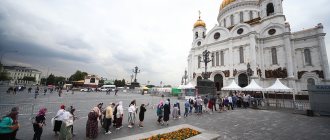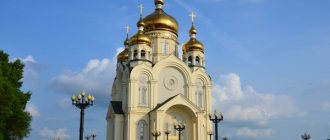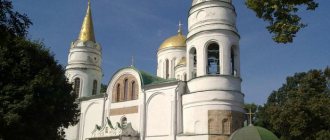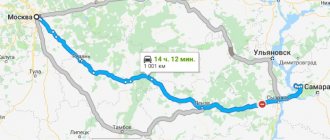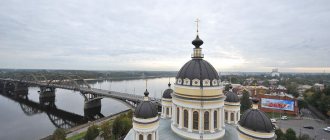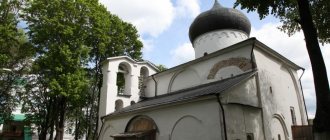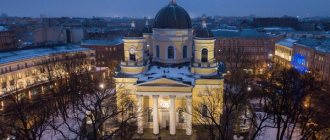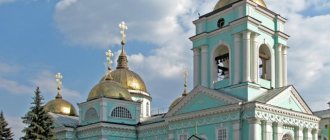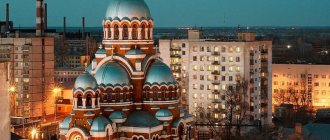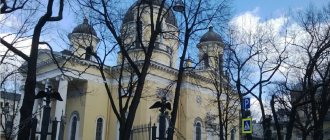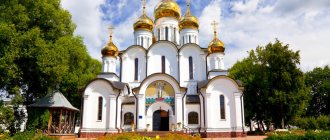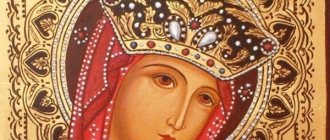The Transfiguration Cathedral in Pereslavl Zalessky was erected in 1152, at the same time the city itself was built. The cathedral has been well preserved to this day and today is a museum-reserve that can be visited at certain hours. Today it is one of the main city-forming structures in the Yaroslavl region. In 1958, a monument to Alexander Nevsky was erected in front of the temple on Red Square.
History of the cathedral
The temple building has a rich history. The ancient building today has sunk 90 cm underground. The walls are more than a meter thick.
Construction and foundation
Prince Yuri Dolgoruky, son of Vladimir Monomakh, founded the cathedral in the 12th century. The walls of the structure are made of well-hewn blocks of white stone using the semi-rubble technique. The stone blocks were laid almost without binding materials and fitted to each other with great precision. Then the gaps between the cobblestones were filled with fragments of stone, rubble and brick. The result was a wall that was filled with lime mortar. A similar laying technique was used mainly in Rome.
The strip foundation of the temple is made of cobblestones and lime. The base goes to a depth of approximately 1.2 meters and reaches a dense layer of clay.
Historical fate
The death of Vladimir Monomakh suspended the construction of the shrine. Andrei Bogolyubsky, the son of Dolgoruky, completed the construction work 5 years later, in 1157.
Alexander Nevsky was baptized in this temple. The cathedral became a burial place for Russian princes. Within its walls, the son of Alexander Nevsky, Dmitry Alexandrovich, and the grandson of Alexander Nevsky, Ivan Dmitrievich, found their peace.
The chapel was destroyed many times. This happened during the Tatar-Mongol raids. A lot of valuables were stolen. The cathedral was restored after each raid.
Meetings of the Russian Orthodox Church have been held in the temple since 1310. Sergius of Radonezh was ordained a priest here. Ivan the Terrible himself came on pilgrimage several times.
Under Soviet rule, the temple worked, but intermittently, and was eventually closed. While the cathedral was empty, the building was destroyed and the roof leaked.
The Bolsheviks took out:
- holy relics;
- church utensils;
- expensive gifts belonging to the holy land.
The building was restored in the 2000s.
Basic transformations:
- walls have been restored and strengthened;
- the cross is gilded;
- roof replaced.
History of frescoes
The temple suffered not only from the harmful effects of moisture and time. The restoration workers caused the greatest damage to it.
“The Last Judgment” and “Our Lady on the Throne” are frescoes that were found in 1862 by N.A. Artleben, famous architect (architect) and local historian. In 1893-94. restoration was carried out, and the shrines were carefully removed with a thin layer of walls. They were put in boxes - they wanted to carry out the restoration in Moscow, since they did not have the opportunity to carry it out on site. No money was allocated for transportation.
At a meeting of Archaeologists in 1895, it was decided that the frescoes did not deserve further storage. They were piled haphazardly in the cold basement. Only one small piece is well preserved. You can admire it at the Moscow Historical Museum. The fragment bears this name - a half-length image of the Apostle Simon.
All the frescoes, which once upon a time were a decoration of the shrine, were cleaned off in the 19th century (during the process of restoration work). They considered them to be of no value. And now the cathedral has just empty walls.
Current situation
Now the temple is an ancient monument and belongs to the St. Nicholas Monastery. Services are held there rarely, only 3 times a year. The cathedral has the status of a museum-reserve and is the main exhibit.
Thousands of tourists visit Pereslavl Zalessky throughout the year. Many pilgrims come here to get inside the temple and enjoy the spirit of bygone times. To date, the museum has welcomed more than 70,000 people.
Preserved monuments of the Kremlin
Very few monuments of the Pereslavl Kremlin have survived to this day. The most famous is, of course, the Transfiguration Cathedral.
Also, tourists today can see earthen ramparts from the 12th century. 16th century building - Church of Peter the Metropolitan. This is an Orthodox church built in the form of a tent, unconventional for its time. Therefore, this architectural monument is considered unique. True, you can’t get into the church now; it is closed for restoration.
Part of the buildings of the Bogoroditsko-Sretensky Monastery has been preserved from the 18th century. If you come to Pereslavl, this monastery is a must-visit. It was founded in 1659. However, already in the middle of the 18th century it was abolished, turning all the churches into parish ones. The monastery suffered severe destruction during Soviet times. In 1933, the fence and bell tower were practically destroyed.
Architecture and decoration of the building
The modern temple is a structure about 21 m high (a five-story building measuring 20 meters). This building belongs to single-domed churches and has 4 pillars.
Appearance
Both externally and internally the temple is quite simple and austere. The base of the dome is a drum, decorated with brickwork at an angle - a curb, as well as a crenate belt - a strip of ornament with stepped hanging teeth. The old earthen rampart surrounding this magnificent building remains in excellent condition.
Wall graffiti
When restoration work was carried out in the 2000s, wall graffiti was discovered on the walls. The reign and failures of Andrei Bogolyubsky did not suit the city residents. There was a conspiracy and the prince was killed. The graffiti (inscription) tells about this event. Moreover, it contains the names of those who were involved in the conspiracy and directly in the murder.
Interior design
Previously, the temple had a wooden iconostasis, but it had to be replaced during restoration in the 19th century. Now there is an altar barrier made of marble here. It was made in a pseudo-Byzantine style and decorated with paintings.
In ancient times this barrier was illuminated by the torches of Horace. This is a lamp that consisted of two bowls. Candlesticks were attached to the lower one. The two bowls were fastened with thin metal chains, and the lamp itself was attached to the arch with special hooks.
Temple shrines
The shrines of the temple include:
- Icon "Transfiguration". Created in the 15th century. According to some sources, it was written by Theophanes the Greek. It can be seen in the Tretyakov Gallery.
- A fragment of a fresco painting - an image of the Apostle Simon.
- Church silver cup (chalice), dating from the 12th century. It can be seen in the Armory Chamber of the Moscow Kremlin.
- Seal of the Archimandrite, dating from the 13th-14th century.
Unique graffiti
The cathedral is also famous for its unique graffiti that was discovered during restoration. On its walls there are ancient Russian inscriptions of various contents.
The most amazing wall recording contains information about the murder of Prince Andrei Bogolyubsky, committed in the 12th century. This was the Grand Duke of Vladimir, who ascended the throne after Yuri Dolgoruky. He died as a result of a conspiracy organized due to the defeat of the prince's troops during the assault on Kyiv and Vyshgorod in 1173. Angered by constant failures, the boyars stabbed the prince to death.
On the wall of the cathedral in Pereslavl-Zalessky there is even a list of the names of the boyars involved in this murder.
Worship and other visiting opportunities
The Orthodox Church welcomes everyone from the first of May to the first of October. Divine services are held 3 times a year on great church holidays and only in the warm season.
Mondays are a day off. Also on the last Tuesday of every month there are sanitary days.
The museum is ready to welcome everyone from 10-00 to 17-00 from October to April, and from 10-00 to 18-00 from May to September. The ticket office closes 15 minutes earlier. Excursions must be booked in advance.
Cost of excursions in 2021:
- 50 rubles - children's ticket;
- 80 rubles - adult;
- 500 rubles – excursion (45 minutes).
Other churches and temples of Pereslavl-Zalessky
In Zalesskoye you can see many churches and temples. If you decide to go to this city, be sure to visit other temples.
Church of the Intercession
Visiting is possible daily from 8-00 to 12-00. The church is interesting both for its external and internal interior. Made in Baroque style. Be sure to pay attention to the gospel from 1701 and the altar cross, which has an inscription from 1758.
Znamenskaya Church
Built in memory of Princess Evdokia, wife of Dmitry Donskoy. You can visit the church on weekends from 8-00 to 14-00.
The shrine is interesting because it was completely destroyed by the Soviet regime. After some time, a liquor store was opened on this land. Later the chapel was rebuilt. Construction lasted about 10 years and began in 1999.
Church of the Forty Martyrs of Sebaste
Open to visitors on Saturdays and Sundays from 7-30 to 23-00. The church should be visited for the beautiful paintings located in the main and warm confines of the temple. The main one was fully scheduled for 2021. The warm limit was set in 2013.
Nikolsky Monastery
It was created in the middle of the 14th century. Receives visitors daily from 8-00 to 20-00.
What interesting things are kept in the monastery:
- icon of the Pope with a particle of relics;
- Korsun cross;
- cancer with 84 particles of the relics of the Kiev-Pechersk saints.
Pereslavl Kremlin
The monastery and cathedral are located on the territory of the Pereslavl Kremlin, in the very center of the city. The Kremlin was founded in the 12th century. In those years, the fortress was surrounded on all sides by water. Shafts were built over a distance of two kilometers. They have survived to this day. Their height varies from 10 to 12 meters.
In the Middle Ages, wooden fortress walls were built on the crest of the rampart, on which towers were located. Such defensive structures were built already in 1194 by the son of the Kremlin founder Yuri Dolgoruky, Vsevolod the Big Nest.
In the 13th century it was one of the most powerful fortresses in the entire Vladimir-Suzdal land. Only the Vladimir Kremlin surpassed it. The towers in which the gates were built were approached by a bridge over a moat with water. True, how many towers there were in the Pereslavl Kremlin is still unknown. Most of the structures have not survived.
For many years, the Transfiguration Cathedral was the only stone building in the Kremlin. Everything else was wooden. In the pre-Mongol era, princely mansions, also wooden, adjoined the cathedral, from which staircases led to the cathedral and towers.
